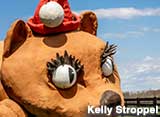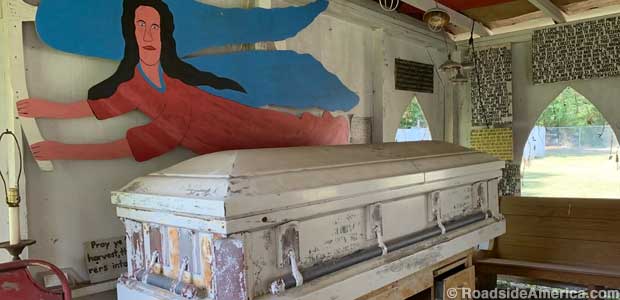
The Casket of Names is filled with messages from Garden visitors.
Howard Finster's Paradise Garden
Summerville, Georgia
"This is Howard Finster, telling you how it's done," said the voice of the late Rev. Howard Finster (1916-2001), broadcast over a hidden loudspeaker in his Paradise Garden. We listened for a half-hour, and Howard, being Howard, never told how he made Paradise Garden; instead, he gave a spirited demonstration of bird calls; played his banjo; yodeled; talked about the meanness of raccoons; and described how he once accidentally cut off his finger with a butcher knife, but then his doctorin' sister tied it up with a piece of flour sack and the pieces grew back together.
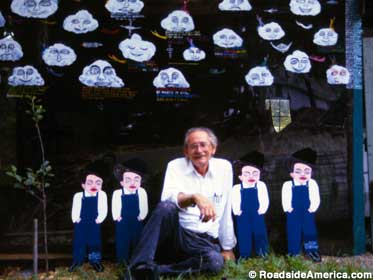
Howard Finster relaxes with his Garden art in 1988.
Howard's sculptures and paintings made at Paradise Garden -- now among the most prized "visionary art" in America -- are similarly bewildering. Experts have exhausted themselves trying to interpret Howard's 10-foot-tall tower of pop bottles, or his paintings of puffy clouds with human faces, but all Howard wanted was for people to look. If they did, maybe a few would accept Jesus and not be eternally damned on the Day of Judgment. "I never seen a person I didn't love," Howard wrote frequently on the walls and art in Paradise Garden, but Howard's God was less forgiving.
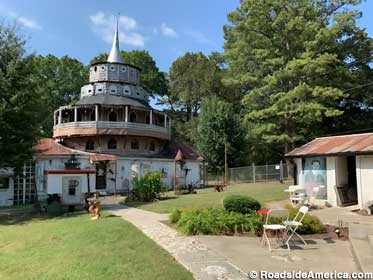
The twelve-sided World's Folk Art Church, Inc., built by Howard without blueprints.
Howard burst into America's pop culture consciousness in the 1980s, although he'd been crafting his "sacred art" at Paradise Garden for years before that. An appearance on The Tonight Show, and album covers for R.E.M and the Talking Heads, propelled him into the American mainstream. Paradise Garden, a four-acre plot at the end of a narrow street in a little town, became a destination for celebrities and cool young people. Howard was not a sullen loner; he'd been a preacher for decades; he knew how to spin a yarn and entertain a crowd.
And then Howard died. Paradise Garden quickly grew ragged and swampy. The gates were closed. The buildings sank in the mud. Any artwork that wasn't nailed down was hauled away.
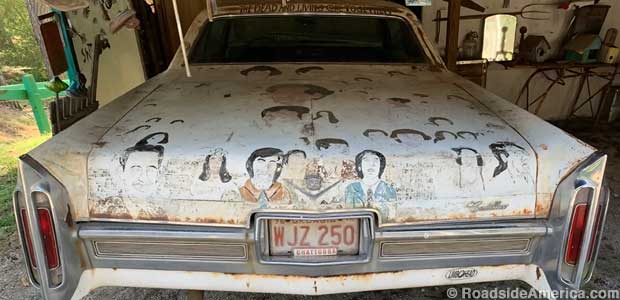
Howard covered his 1983 Cadillac with Sharpie portraits of friends and celebrities.
But Howard's Paradise did not fall to the backhoe or succumb to Georgia weather. His fans finally got their act together, stopped the decay, and reopened his Garden to the public in 2012. Since then its restoration has been a work in progress, slowly, because it takes more time and money to preserve art made of junk than it does to create it.
"Why is this special? Why did this resurrect? Because this place is the Holy Grail," said Tina Cox, executive director of the Paradise Garden Foundation. "I have benchmarked Paradise Garden against just about every other art environment," she said (Tina came from a corporate background). "As far as I'm concerned, Paradise Garden is in the top five in the world."
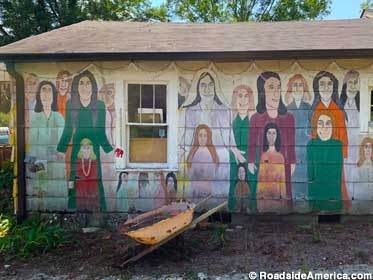
The happy people of Nineveh fill Howard's workshop wall.
Visitors enter the Garden through Howard's old bungalow studio, its clapboard exterior painted with smiling portraits of President George Washington and the saved-when-they-repented people of biblical Nineveh. An introductory video and gallery give an overview of Howard and his work, then it's out the back door and onto the Garden grounds for a self-guided tour.
The "World's Folk Art Church, Inc." dominates the skyline, a twelve-sided four-layer wedding cake of a building constructed out of scraps, untreated lumber, and plywood. "It's amazing it's still standing," Tina said. The Church is currently closed to visitors, although repairing and reopening it is a key goal of the Garden's restoration. We've clomped through roadside structures that looked far more flimsy, but we also understand the need for caution: no one wants an unsuspecting tourist to accidentally collapse Howard's architectural masterpiece.
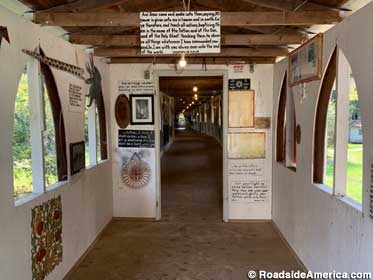
Entrance to the Rolling Chair Ramp Gallery.
Cutting across the property is the Rolling Chair Ramp Gallery, an elevated covered walkway that displays some of Howard's surviving Garden artwork and a lot of art left by friends and fans, often in tribute to his style. The Gallery was built by Howard, said Tina, after he'd pushed a visiting paraplegic Vietnam vet around in a wheelbarrow and realized his Garden wasn't as accessible as he'd thought. "Howard was so polite he would never say it was a wheelchair ramp," Tina said.
On the ground beneath the elevated Gallery is the Tomb of the Unknown Body, encasing the corpse of a 17-year-old who'd been dead an estimated 100 years when she was given to Howard by a local undertaker. Howard built a sarcophagus with a glass window so visitors could see the teenager's teeth, but when the glass cracked Howard sealed it over. Another macabre gift to the Garden is the Casket of Names in the Meditation Chapel. Howard wanted to be cremated and had no need for a casket, so he used it as a kind of permanent mailbox for any visitor who wanted to leave him a note. "I figure I can put a million in there," Howard said at the time.
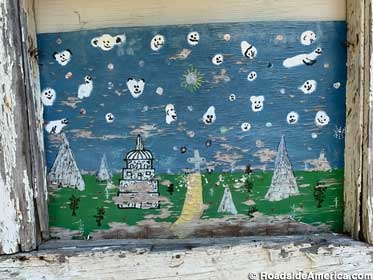
Typical Finster landscape: soaring temples, cone mountains, and puffy clouds with human faces.
The walls and pathways of Howard's Mosaic Garden -- the oldest part of the property -- are lined with embedded marbles, broken dishes, cracked mirrors, shells, light bulbs, and various bric-a-brac salvaged by Howard from the local dump. In this section is Howard's "Serpent of the Wilderness" sculpture, a multi-ton pile of writhing cement snakes also known as the R.E.M. Serpent Mound after its use by the band in their early promotional material. Why did Howard create it, or the seven-foot-long cement shoe, or the a birdcage filled with plastic toys and a rusty carburetor? Why did he take his 1983 Cadillac, given to him by an admirer, and cover it with Sharpie portraits of his friends and a tribute to his first ride in an airplane? "You and I might look at these things and go, 'Huh?'" said Tina. "But these were important pieces to him."
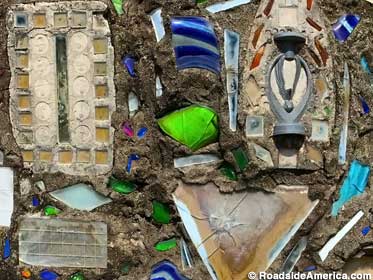
The Mosaic Garden is made with bric-a-brac salvaged by Howard from the local dump.
Howard's various worksheds, which had fallen into a state of near-collapse after his death, have been restored and reopened to show how Howard carefully organized his now-rusty bicycle parts and other supplies. And although Howard's outdoor paintings have weathered and bleached over the years, the routine maintenance of the Garden seems to have resurrected more art than has been lost. Just regular dusting and weed-whacking has helped a lot.
Tina said that the mission of 21st century Paradise Garden is to be a hub of "cultural tourism," and the property already hosts music and movie events, a children's art camp, adult painting classes, holiday parties, traveling art exhibits, and a "Finster Fest" every May. The Garden now has an archival center, an event space, and comfortable Airbnbs for overnight visitors. It struck us as perhaps a bit luxuriant for Howard's Jesus-is-coming, scavenge-the-junkyard roots, and we asked Tina if she thought Howard would be overwhelmed by it all.
"Listen, The Tonight Show with Johnny Carson wasn't overwhelming for Howard," said Tina. "Nothing was overwhelming for Howard."




